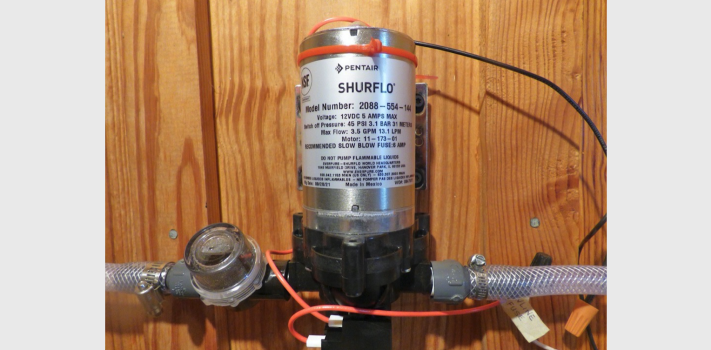As we saw in 2021 here in the U.S., grid-down events lasting several days can occur at any time of the year. Some of the major ones making the headlines were caused by forest fires, multi-state tornados, and near record-setting wind storms. Most of us deal more regularly with local blackouts caused by wind and ice storms, outages that can happen anywhere at any time. Are we prepared?
We take water for granted. It’s always there when we open a tap or flush the toilet and often we’re not prepared when it’s not readily available for a several-day period. Here, I present an emergency backup system that can be fairly easy and inexpensive to install depending on the design of your plumbing system. For those who think the world is headed for rough seas ahead and possibly longer power outages, a backup water system could be a wise idea even if it means spending a little more money than you’d like.
PLANNING AHEAD
The year before I bought my homestead property a big ice storm in my area took the grid down for four days. I factored that into my plans when I started building the following year. Using the two-is-one-and-one-is-none philosophy, all of my systems have backups that work a different way such as a propane heater replacing my electric well-house heater. Since my solar panels are grid-tied for now, my plumbing system is designed using a 220-volt well pump, 110-volt pressure pump, and 110-volt well-house heaters.
When the grid temporarily goes down and 110V/220V is no longer available, this emergency water-supply system using a 12V water pump is the simplest, least-expensive, and most reliable one I could come up with. If you have a propane or alternate non-electric water heater, it will also provide all the hot water you normally use.
Let’s dig into the details.
WIRELESS TEMPERATURE ALARMS
Part of my wintertime plumbing security features wireless temperature sensors with alarms (Photo 1). These use AA batteries and the alarms are loud enough to wake me out of a sound sleep to warn me the well-house temperature is below my set point of 37°F. I can then check to see if the electric space heaters are working properly and fire up the propane wall heater, if necessary.
Most of these units are advertised as freezer alarms. So as a side note, with a sensor inside the freezer the base unit allows you to see the current temperature at any given moment. If the grid fails, freezer temperatures can be monitored and food left in place until either the grid comes back up or it’s time to move to Plan B.
The left number in Photo 1 shows the freezer temperature of -10°F and on the right, the well-house temperature at 36°F. (Please note this photo is an example only, not my actual set points. Also, the min/max numbers are not the alarm set points, rather the hi/lo temps over the last 24 hours.)
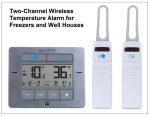
WELL HOUSE and WATER-STORAGE TANK
After that four-day ice storm, I decided having a 500-gallon water storage tank (Photo 2) in my well house was a non-negotiable requirement. It not only gets me through a week or three if my ancient well pump finally gives up the ghost, but also gives me a large enough water supply to handle any temporary grid-down situation without having to haul water from the lake or water barrel and purifying it before use.
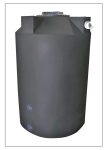
I recommend having the largest water tank you have room for, and that it be plumbed directly into your plumbing system whether the tank is in your house, garage, or well house. When plumbed in, it also has the advantage of constantly refreshing the water inside.
WATER WELL
My current water-well pump uses 220V and in a grid-down event, a generator is used to fill my 500-gallon tank in about 40 minutes if the tank is nearly empty. This setup allows me to get 500 gallons of water any time I need it. Without a water tank, there are no convenient ways to store enough clean water for normal daily use during a power outage.
BACKUP WATER SYSTEM
For those who already have water-storage tanks in their plumbing systems, this backup system should cost less than $100 to install plus the cost of a 12V battery if you need to buy one. For those without a water tank, new 500-gallon tanks start around $525 and go up from there. Larger or smaller tanks are priced accordingly.
My system uses a 12VDC RV water pump and a 12VDC deep-cycle battery. There are many different ways to tailor this to your particular plumbing layout. Diagram 1 shows how I currently have it tied into my plumbing which is shown in more detail below:
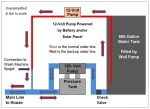
PRESSURE TANKS
Before I go into more detail, it’s important to understand how water lines are pressurized to provide a strong stream of water whenever you open a faucet.
When you squeeze a balloon, the air pressure inside the balloon increases and if squeezed hard enough, the air pressure increases enough to pop the balloon. If you have your own well, or in some homes on municipal water systems who want a more constant water pressure, your plumbing system is pressurized by the same principle, using a small pressure tank with a large rubber air bladder inside. When not under pressure, the air bladder typically takes up two-thirds of the space inside the tank.
As water is pumped into the line, it squeezes the bladder until the air pressure inside reaches 50 psi, at which point a pressure switch shuts the pump off. When a faucet is opened anywhere in the system, the compressed air inside the bladder provides the pressure to push water out of the faucet. As water leaves the faucet, the pressure inside the bladder drops until it reaches 30 psi, whereupon the pressure switch turns the pump on to add more water from the well or storage tank to re-pressurize the bladder to 50 psi. These pressure numbers are typical but can be adjusted to fit your situation.
IN-LINE EMERGENCY WATER SYSTEM
My emergency water system uses a Shurflo 12V water pump (Photo 3), but other brands can be used as long as they’re designed for potable water. The Shurflo pump I use has its own pressure switch and is set to turn on at 25 psi, then turn off once the pressure reaches 45 psi. It pumps 3.5 gpm and at $65 it’s well priced and one of the most popular and long-lasting pumps for RV usage.
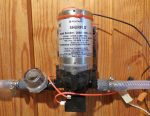
Diagram 2 shows how all water pipes in a typical plumbing layout are interconnected so each faucet and spigot has more or less the same pressure. This means a 12V water pump can pull water out of the tank and push it into any spigot in the entire system to pressurize the lines, giving you a lot of latitude as far as setting up your own backup water supply goes.

My Shurflo pump takes water out of the tank (Photo 4), then pumps it down a length flexible hose which has a garden hose adapter on the far end. This flexible line can be attached to any faucet having garden-hose thread such as an outdoor faucet, the drain line on my pressure tank, or the washing machine cold-water spigot which is what my system uses (Photo 5). From there the entire system is pressurized as water moves through the washing machine spigot into the plumbing lines, forcing water into the pressure tank to compress the air bladder.
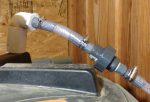
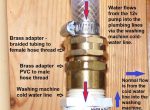
Now refer back to Diagram 1 to get a better idea of how the overall system works.
BACKUP WATER LINE PERMANENT ATTACHMENT
As soon as summer gets here, I want to reconfigure a few of the plumbing lines in my well house and as part of the upgrade I’ll be “hard-wiring” the 12V water pump into my plumbing layout to resemble Diagram 3. This over-simplified diagram shows how a 12V pump can be plumbed directly into in the main PVC lines via a side loop. By opening valves A & B and closing valve C, water will be diverted through the 12V pump line to pressurize the system, bypassing the 110V pump.
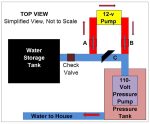
BATTERIES
A lot can be said about all the details of proper battery types, usage, and depth of discharge, but that’s a long discussion for another day. I use a 12V deep-cycle battery ($100) which is rated for 122 amp hours. Initially, I tested the system to see if the battery would work for five days without recharging and without drawing the battery down more than 20%. Since I don’t open faucets too many times during the day, the battery had ample time to recover between pump-on cycles so it wasn’t until the 11th day that the battery finally dropped to 80% charged.
ACTUAL USAGE
Since I have a composting toilet, during the winter I only need water for drinking, showering, dishes, and washing clothes, averaging less than 100 gallons per week. That gives me a month of wintertime usage from my 500-gallon tank.
I measured how water much I use for showering by inserting the tub plug, showering, and then scooping the water into a 5-gallon bucket. By weighing it in grams and converting to gallons, I discovered I only use 2.6 gallons of water to take a shower. During the test, there was never a drop in water pressure and I couldn’t tell the difference between the 12V pump and my regular 110V pump. The next day I took a long leisurely shower using 5 gallons and didn’t regulate the water as I normally do using the showerhead flow-adjusting valve. There still wasn’t a noticeable drop in pressure. The only noticeable drop was while filling larger kettles of water in the kitchen sink. The normal 110V pump turns on when the pressure drops to 30 psi, the Shurflo when it gets down to 25 psi, so that 5 psi difference was noticeable while standing there impatiently waiting for the kettle to fill. If that’s too annoying for some, the Shurflo can be adjusted to come on at 30 psi.
For clothes washing, I switch the 12V pump line from the washing machine cold-water faucet to the pressure tank drain faucet. (It’s in the way or I’d keep it there permanently.) The washing machine is an EnergyStar water-conserving type and for a typical load I measured 16½ gallons by putting the waste-water line in a tote and measuring the volume. The Shurflo pump was on for a total of 7.1 minutes, a small amount of time compared to how little that drains the battery. For those doing the math, the pump efficiency drops as water re-pressurizes the lines to a full 45 psi, so instead of a constant 3.5 gpm it pumps less and less water as the line pressure increases.
YOUR HOUSEHOLD FACTORS
Depending on the size of your household and other factors, your experience may differ but will still provide all the water you need. When not possible to recharge the battery using a generator or solar, battery power can be conserved by using less water. Using paper plates and plastic silverware, letting dishes stack up and doing them once a day, and waiting until the grid is back up instead of manually washing clothes are just a few ways. Flow valves such as the one I use are available which screw in right above the shower head to allow you to wet down, then reduce the flow or turn it off altogether while you soap up, then back to a higher flow rate to rinse off. Using one can get your shower-water usage down to as little as three to five gallons.
For those with a generator, it’s impractical to keep it running all day since the majority of household items use electricity only sporadically. This includes well pumps, water pressure pumps, refrigerators and freezers, and electric water heaters among others. By running the generator once a day for an hour or so, the refrigerators and freezers can be brought back down to the necessary temperatures, 500-gallon water tanks can be filled if needed, water heated, and cell phones charged. All of these can get by with an hour or two of generator electricity except the 110V water pressure pump. For this reason alone, having a 12V pump and deep-cycle battery as a backup is well worth the investment.
CONCLUSION
I like this setup not just because it was fairly easy and inexpensive to install, but during a grid-down situation it continues to supply water via the normal plumbing lines, including hot water if your water heater is propane, solar, or wood-fired, and for all intents and purposes the performance was equal to my regular 110V pump. The Shurflo pump isn’t designed to run continuously for things like garden watering, but for normal household use, you probably won’t notice much difference.
After pulling the plug on my 110V water pump and using the Shurflo exclusively for a long-term test of my preps, it’s surpassing my expectations — especially with how long it takes the battery to discharge 20% down to a very battery-friendly 80% state of charge. Since it uses the same pressure tank as my 110V pump, there’s virtually no difference when showering, washing dishes, or using the washing machine.
For anyone needing a grid-down backup water system, some version of this system is a good way to go.

